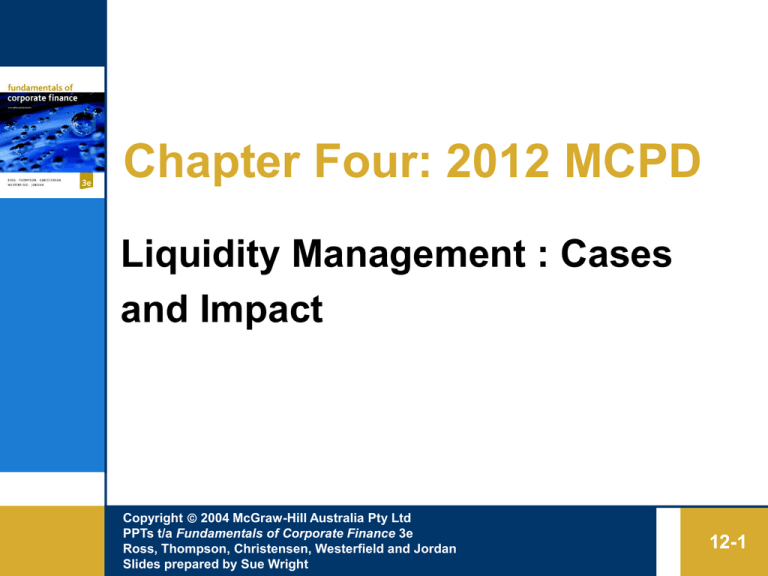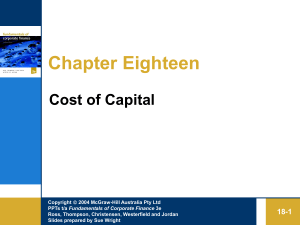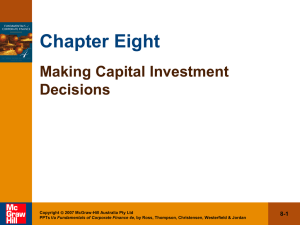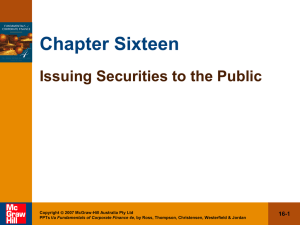
Chapter Four: 2012 MCPD
Liquidity Management : Cases
and Impact
Copyright 2004 McGraw-Hill Australia Pty Ltd
PPTs t/a Fundamentals of Corporate Finance 3e
Ross, Thompson, Christensen, Westerfield and Jordan
Slides prepared by Sue Wright
12-1
26-2
Executive Summary
We are solidly in to the third great question of
corporate finance.
McGraw-Hill/Irwin
Corporate Finance, 7/e
© 2005 The McGraw-Hill Companies, Inc. All Rights Reserved.
26-3
The Balance-Sheet Model of the Firm
The Capital Budgeting Decision
Current
Liabilities
Current Assets
Long-Term
Debt
Fixed Assets
1 Tangible
2 Intangible
McGraw-Hill/Irwin
Corporate Finance, 7/e
What longterm
investments
should the
firm engage
in?
Shareholders’
Equity
© 2005 The McGraw-Hill Companies, Inc. All Rights Reserved.
26-4
The Balance-Sheet Model of the Firm
The Capital Structure Decision
Current
Liabilities
Current Assets
Fixed Assets
1 Tangible
2 Intangible
McGraw-Hill/Irwin
Corporate Finance, 7/e
How can the firm
raise the money
for the required
investments?
Long-Term
Debt
Shareholders’
Equity
© 2005 The McGraw-Hill Companies, Inc. All Rights Reserved.
26-5
The Balance-Sheet Model of the Firm
The Net Working Capital Investment Decision
Current Assets
Fixed Assets
1 Tangible
2 Intangible
McGraw-Hill/Irwin
Corporate Finance, 7/e
Current
Liabilities
Net
Working
Capital
How much shortterm cash flow
does a company
need to pay its
bills?
Long-Term
Debt
Shareholders’
Equity
© 2005 The McGraw-Hill Companies, Inc. All Rights Reserved.
26-6
26.1 Tracing Cash and Net Working Capital
Current Assets are cash and other assets that are expected to be
converted to cash with the year.
Cash
Marketable securities
Accounts receivable
Inventory
Current Liabilities are obligations that are expected to require cash
payment within the year.
Accounts payable
Accrued wages
Taxes
McGraw-Hill/Irwin
Corporate Finance, 7/e
© 2005 The McGraw-Hill Companies, Inc. All Rights Reserved.
26-7
26.2 Defining Cash in Terms of Other Elements
Net Working
Fixed
+
=
Capital
Assets
Net Working
Capital
= Cash –
LongTerm +
Debt
Equity
Other
Current
Current +
Liabilities
Assets
LongNet Working
Fixed
Cash = Term + Equity –
–
Capital
Assets
(excluding cash)
Debt
McGraw-Hill/Irwin
Corporate Finance, 7/e
© 2005 The McGraw-Hill Companies, Inc. All Rights Reserved.
26-8
26.2 Defining Cash in Terms
of Other Elements
LongNet Working
Fixed
Cash = Term + Equity –
–
Capital
Assets
(excluding cash)
Debt
An increase in long-term debt and or equity leads to an
increase in cash—as does a decrease in fixed assets or a
decrease in the non-cash components of net working
capital.
The Sources and Uses of Cash Statement follows from
this reasoning.
McGraw-Hill/Irwin
Corporate Finance, 7/e
© 2005 The McGraw-Hill Companies, Inc. All Rights Reserved.
Current Investment Decisions
• Involve the administration of the company’s current
assets
(cash
and
marketable
securities,
receivables and inventory), and the financing
needed to support these assets.
• Problems in using discounted cash flow techniques
to evaluate these decisions:
–
–
–
identification of all relevant cash inflows and outflows
determining the size and timing of these cash flows
determining the correct discount rate.
Copyright 2004 McGraw-Hill Australia Pty Ltd
PPTs t/a Fundamentals of Corporate Finance 3e
Ross, Thompson, Christensen, Westerfield and Jordan
Slides prepared by Sue Wright
12-9
Operating Cycle versus Cash Cycle
• Operating cycle—the time period between the
acquisition of inventory and the collection of cash
from receivables.
Operating cycle = Inventory period + A/cs receivable period
• Cash cycle—the time period between the outlay of
cash for purchases and the collection of cash from
receivables.
Cash cycle = Operating cycle – A/cs payable period
Copyright 2004 McGraw-Hill Australia Pty Ltd
PPTs t/a Fundamentals of Corporate Finance 3e
Ross, Thompson, Christensen, Westerfield and Jordan
Slides prepared by Sue Wright
12-10
Cash Flow Time Line
Cash
received
Inventory
sold
Inventory
purchased
Inventory
period
Accounts receivable
period
Time
Accounts
payable period
Cash paid
for inventory
Operating cycle
Cash cycle
Copyright 2004 McGraw-Hill Australia Pty Ltd
PPTs t/a Fundamentals of Corporate Finance 3e
Ross, Thompson, Christensen, Westerfield and Jordan
Slides prepared by Sue Wright
12-11
Example—Operating Cycle
The following information has been provided for Overcredit
Co.:
Ite m
In v e n to ry
A cco u n ts re ce iv a b le
A cco u n ts p a y a b le
B e g in n in g
$90 000
$72 000
$49 000
E n d in g
$102 000
$78 000
$55 000
Sales for the year were $510 000 (assume all credit) and
the cost of goods sold was $350 000.
Calculate the operating cycle and cash cycle.
Copyright 2004 McGraw-Hill Australia Pty Ltd
PPTs t/a Fundamentals of Corporate Finance 3e
Ross, Thompson, Christensen, Westerfield and Jordan
Slides prepared by Sue Wright
12-12
Example—Operating Cycle (continued)
a) Find the inventory period:
Inventory
turnover
COGS
Avg. inventory
90
350 000
000 102 000
2
3 .65 times
Inventory
365
period
Inventory
turnover
365
3 .65 times
100 days
Copyright 2004 McGraw-Hill Australia Pty Ltd
PPTs t/a Fundamentals of Corporate Finance 3e
Ross, Thompson, Christensen, Westerfield and Jordan
Slides prepared by Sue Wright
12-13
Example—Operating Cycle (continued)
b) Find the accounts receivable period:
Receivable
s t/o
Credit sales
Avg. receivable
s
510 000
72 000 78 000
2
6.8 times
Receivable
365
s period
Receivable
s t/o
365
6.8 times
53.7 days
Copyright 2004 McGraw-Hill Australia Pty Ltd
PPTs t/a Fundamentals of Corporate Finance 3e
Ross, Thompson, Christensen, Westerfield and Jordan
Slides prepared by Sue Wright
12-14
Example—Operating Cycle (continued)
Operating
cycle Inventory
period Receivable
s period
100 53.7
153.7 days
Copyright 2004 McGraw-Hill Australia Pty Ltd
PPTs t/a Fundamentals of Corporate Finance 3e
Ross, Thompson, Christensen, Westerfield and Jordan
Slides prepared by Sue Wright
12-15
Example—Cash Cycle
a) Find the payables period:
COGS
Payables t/o
Avg. payables
49
350 000
000 55 000
2
6 .73 times
Payables
365
period
Payables turnover
365
6 .73 times
54 .2 days
Copyright 2004 McGraw-Hill Australia Pty Ltd
PPTs t/a Fundamentals of Corporate Finance 3e
Ross, Thompson, Christensen, Westerfield and Jordan
Slides prepared by Sue Wright
12-16
Example—Cash Cycle (continued)
Cash cycle Operating cycle Payables
period
153.7 54.2
99.5 days
Copyright 2004 McGraw-Hill Australia Pty Ltd
PPTs t/a Fundamentals of Corporate Finance 3e
Ross, Thompson, Christensen, Westerfield and Jordan
Slides prepared by Sue Wright
12-17
Short-term Financial Policy
• Size of investments in current assets
-Flexible policy—maintain a high ratio of current assets to
sales
-Restrictive policy—maintain a low ratio of current assets to
sales
• Financing of current assets
- Flexible policy—less short-term debt and more long-term
debt
- Restrictive policy—more short-term debt and less long-term
debt
Copyright 2004 McGraw-Hill Australia Pty Ltd
PPTs t/a Fundamentals of Corporate Finance 3e
Ross, Thompson, Christensen, Westerfield and Jordan
Slides prepared by Sue Wright
12-18
Short-term Financial Policy
•
The size of the firm’s investment in current assets is
determined by its short-term financial policies.
•
Flexible policy actions include:
– keeping large cash and securities balances
– keeping large amounts of inventory
– granting liberal credit terms.
•
Restrictive policy actions include:
– keeping low cash and securities balances
– keeping small amounts of inventory
– allowing few or no credit sales.
Copyright 2004 McGraw-Hill Australia Pty Ltd
PPTs t/a Fundamentals of Corporate Finance 3e
Ross, Thompson, Christensen, Westerfield and Jordan
Slides prepared by Sue Wright
12-19
Costs of Investments
•
Need to manage the trade-off between carrying costs and
shortage costs.
•
Carrying costs increase with the level of investment in current
assets, and include the costs of maintaining economic value
and opportunity costs.
•
Shortage costs decrease with increases in the level of
investment in current assets, and include trading costs and
the costs related to being short of the current asset. For
example, sales lost as a result of a shortage of finished goods
inventory.
Copyright 2004 McGraw-Hill Australia Pty Ltd
PPTs t/a Fundamentals of Corporate Finance 3e
Ross, Thompson, Christensen, Westerfield and Jordan
Slides prepared by Sue Wright
12-20
Carrying Costs and Shortage Costs
Copyright 2004 McGraw-Hill Australia Pty Ltd
PPTs t/a Fundamentals of Corporate Finance 3e
Ross, Thompson, Christensen, Westerfield and Jordan
Slides prepared by Sue Wright
12-21
Carrying Costs and Shortage Costs
Copyright 2004 McGraw-Hill Australia Pty Ltd
PPTs t/a Fundamentals of Corporate Finance 3e
Ross, Thompson, Christensen, Westerfield and Jordan
Slides prepared by Sue Wright
12-22
Carrying Costs and Shortage Costs
Copyright 2004 McGraw-Hill Australia Pty Ltd
PPTs t/a Fundamentals of Corporate Finance 3e
Ross, Thompson, Christensen, Westerfield and Jordan
Slides prepared by Sue Wright
12-23
26-24
Alternative Financing Policies for
Current Assets
A flexible short-term finance policy means low
proportion of short-term debt relative to longterm financing.
A restrictive short-term finance policy means
high proportion of short-term debt relative to
long-term financing.
McGraw-Hill/Irwin
Corporate Finance, 7/e
© 2005 The McGraw-Hill Companies, Inc. All Rights Reserved.
26-25
Alternative Financing Policies
for Current Assets
In an ideal world, short-term assets are always
financed with short-term debt and long-term
assets are always financed with long-term debt.
In this world, net working capital is always zero.
McGraw-Hill/Irwin
Corporate Finance, 7/e
© 2005 The McGraw-Hill Companies, Inc. All Rights Reserved.
26-26
Financing Policy for an Idealized Economy
Current assets =
Short-term debt
$
Long-term
debt plus
common
stock
Fixed assets:
a growing firm
0
1
2
3
4
5
Time
Grain elevator operators buy crops after harvest, store them, and sell
them during the year. Inventory is financed with short-term debt. Net
working capital is always zero.
McGraw-Hill/Irwin
Corporate Finance, 7/e
© 2005 The McGraw-Hill Companies, Inc. All Rights Reserved.












